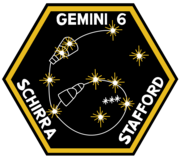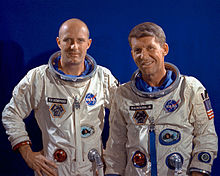 Gemini VI-A (foreground) and Gemini VII make the first rendezvous in orbit between two crewed spacecraft | |
| Mission type | Space rendezvous |
|---|---|
| Operator | NASA |
| COSPAR ID | 1965-104A |
| SATCAT no. | 1839 |
| Mission duration | 1 day, 1 hour, 51 minutes, 24 seconds |
| Distance travelled | 694,415 kilometers (374,954 nautical miles) |
| Orbits completed | 16 |
| Spacecraft properties | |
| Spacecraft | Gemini SC6 |
| Manufacturer | McDonnell. Phrase m |
| Launch mass | 3,546 kilograms (7,818 lb) |
| Crew | |
| Crew size | 2 |
| Members | |
| Start of mission | |
| Launch date | December 15, 1965, 13:37:26 UTC |
| Rocket | Titan II GLV, s/n 62-12561 |
| Launch site | Cape Kennedy LC-19 |
| End of mission | |
| Recovered by | USS Wasp |
| Landing date | December 16, 1965, 15:28:50 UTC |
| Landing site | North Atlantic Ocean 23°35′N 67°50′W / 23.583°N 67.833°W |
| Orbital parameters | |
| Reference system | Geocentric |
| Regime | Low Earth orbit |
| Perigee altitude | 270 kilometers (150 nautical miles) |
| Apogee altitude | 274 kilometers (148 nautical miles) |
| Inclination | 28.9 degrees |
| Period | 89.95 minutes |
| Epoch | December 15, 1965[1] |

 (L-R) Stafford, Schirra | |
Gemini 6A (officially Gemini VI-A)[2] was a 1965 crewed United States spaceflight in NASA's Gemini program. The mission, flown by Wally Schirra and Thomas P. Stafford, achieved the first crewed rendezvous with another spacecraft, its sister Gemini 7. Although the Soviet Union had twice previously launched simultaneous pairs of Vostok spacecraft, these established radio contact with each other, but they had no ability to adjust their orbits in order to rendezvous and came no closer than several kilometers of each other, while the Gemini 6 and 7 spacecraft came as close as one foot (30 cm) and could have docked had they been so equipped.
Gemini 6A was the fifth crewed Gemini flight, the 13th crewed American flight, and the 21st crewed spaceflight of all time (including two X-15 flights over 100 kilometers (54 nautical miles)).
- ^ McDowell, Jonathan. "SATCAT". Jonathan's Space Pages. Retrieved March 23, 2014.
- ^ Hacker, Barton C.; Grimwood, James M. (September 1974). "Chapter 11 Pillars of Confidence". On the Shoulders of Titans: A History of Project Gemini. NASA History Series. Vol. SP-4203. NASA. p. 239. Archived from the original on 2010-01-13. Retrieved 2013-09-26. With Gemini IV, NASA changed to Roman numerals for Gemini mission designations.